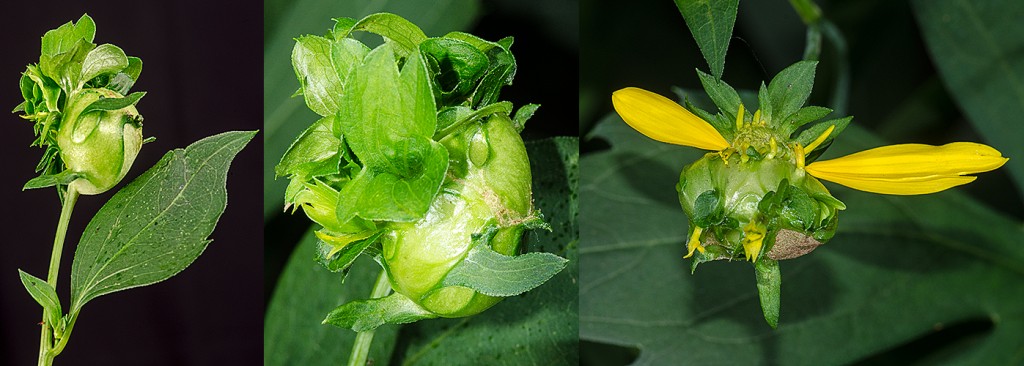Green-headed Coneflower (Rudbeckia laciniata) also goes by the common names Tall Coneflower, or Yellow Coneflower, or Cut-leaf Coneflower. It is commonly seen in the wild and also in so called “prairie plantings.” It is tall, sometimes reaching 10 feet (2.5m) in height, with yellow disk and ray flowers. The ray flowers are not reflexed. It has a smooth stem and pointed leaf tips.
A naturalist friend of mine recently brought me a few galls from her garden in Royal Oak that developed on her Green-headed Coneflowers. It proved to be Asphondylia rudbeckiaeconspicua, one of the Gall Midges. Bugguide.net only had records from Iowa and Virginia. I submitted photos for Michigan. The blog, Field Biology in Southeastern Ohio has an Ohio record. iNaturlist.org has records from Wisconsin and Pennsylvania, Pennsylvania being the type location (the place that the original specimens came from). Wong et al lists it from southern Manitoba.

Closeup of gall larva and sectioned Asphondylia rudbeckiaeconspicua gall along with another affected flower.
I’m wondering if this gall is common but overlooked in Michigan. I have checked eight colonies in Michigan without finding any additional galls. This is the only gall I have ever seen on the genus Rudbeckia. If you find this gall you can submit your photos to bugguide.net.
Copyright 2015 by Donald Drife
Webpage Michigan Nature Guy
Follow MichiganNatureGuy on Facebook




I have had an infestation on my Rudbeckia laciniata over the last two years of the gall midge. This year, an entire section disappeared over the winter from borer damage in the roots. Related? It is a serious problem in northeastern Ohio.
I’m not sure if it’s related or not. If it is the same insect then it can be controlled by picking off the infected flower heads before the insects can infest the crown of the plant. I have not seen the crown stage but I have been watching this colony hoping to get pictures.
I have galls on my Green Headed coneflowers this year (2016). I have photos if anyone is interested. I’ve also sent photos to to the MSU extension in Clinton Twp.
The colony I photographed that had the galls last year has none this year.
I have the galls on mine in the western suburbs of Chicago. I’m so glad I found this information and will go right out and cut off the infected flowers
I also have several galls on my Rudbeckia laciniata which is a new development as I’ve had stands of them for over 5 years. Wasn’t sure if I should eliminate them (the midges/galls) or let them be part of the eb and flow of the natural world in our yard. We get a decent showing of dragonfly, damselfly at the rain garden where I’m seeing them so I know in theory they may represent food along with mosquitos. Too bad your not in the neighborhood. I’d invite you to have at ’em with camera or whatever
🙂
I’m not sure what to recommend for control. The four colonies I found last year had no galls this year. They don’t seem to be a serious pest but certainly have the potential to be on in a garden.
I have a client in central Ohio who has a large amount of Rudbeckia nitida ‘Herbstsonne’. In 2015 there were several of the flower galls found & cut off. In 2016, about 1/3 of the flowers overall had the galls. In 2017, there were only a handful. Always know to keep an eye on them when they flower & cut them off but hoping that being deligent with pruning has reduced the population & quelled an infestation.
All of the colonies I watched died out after one year. They winter at the base of the plants and you can find pictures of the egg mass on-line. Destroying them might be another control method.
I have never seen these before until this year. Southeast Michigan. Ewwwww
I can send pics if needed.
I have them on mine in West Bloomfield, MI and in South Lyon, MI and have had for about five years. They are not going away without treatment as I have hoped. To me they seem to be impacting the health. Almost every flower head in South Lyon is affected. Will pick them off and see what happens.
I’ve noticed the Rudbeckia gall on R. laciniata both at two natural locations in Elgin, Illinois. And one in Rockford, Illinois. I actually transplanted one of the R. laciniata plants with a gall into my home garden, thinking that they would add to my garden’s ecosystem.
Not sure if they are pests detrimental to the plants. Or if they a good food source for dragonflies and birds.